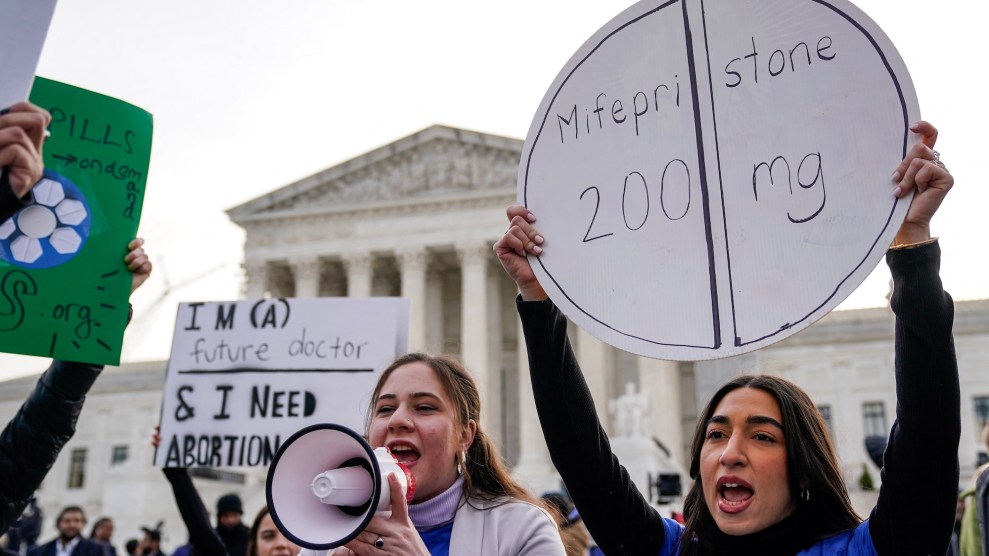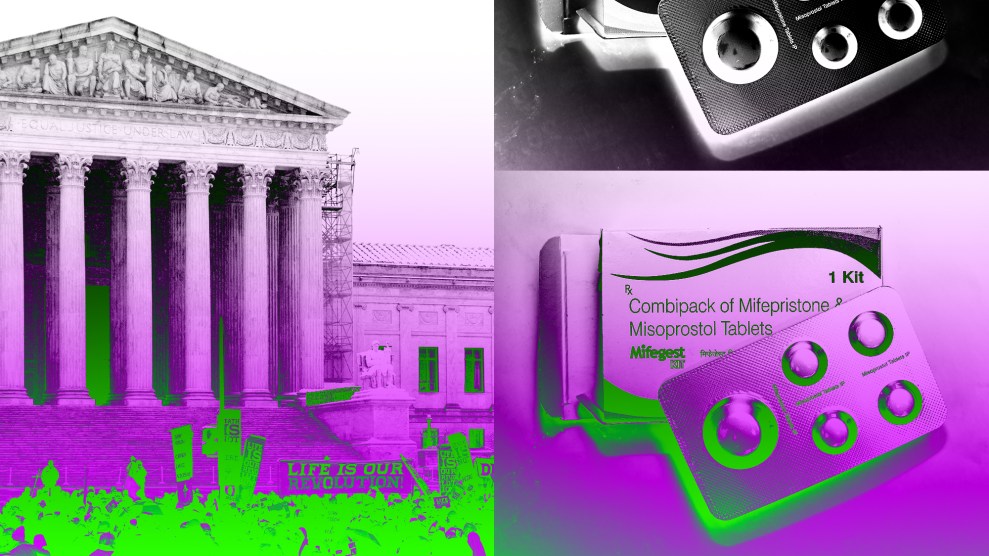
Abortion rights activists rally outside the court on March 26.Drew Angerer/AFP/Getty
The Supreme Court on Tuesday heard its most consequential abortion case since it overturned Roe v. Wade nearly two years ago. This time, the question facing the justices was whether to significantly restrict access to mifepristone, a drug commonly used in medication abortions. Though the Republican-appointed majority clearly does not approve of abortion, most of the justices appeared unwilling to adopt the farfetched legal theories that would justify cutting off access to medication abortion—at least for now.
This case should never have reached the Supreme Court. In order to sue, a potential litigant needs to identify an injury that can be remedied by a court—a bedrock legal principle known as standing. And the plaintiffs in this case, doctors who oppose abortion and the organization they belong to, the Alliance for Hippocratic Medicine, don’t have standing under current Supreme Court precedent. That was the most obvious default with the plaintiffs’ arguments on Tuesday: they didn’t have a right to be there at all.
The doctors are suing under the theory that a small percentage of people who take the abortion drug mifepristone will suffer a serious adverse reaction, requiring a visit to the emergency room, where one of the suing doctors may have to assist in completing the abortion, violating their anti-abortion beliefs. However, under Supreme Court precedent, such a so-called “probabilistic” chain of events is not a sufficient basis for standing. Indeed, at oral arguments, most of the justices did not appear to accept it.
The plaintiffs’ argument “sounded very probabilistic to me,” Kagan told Erin Hawley, the lawyer for AHM and seven named doctors. “There’s some probability or likelihood that one of our doctors who has a conscience objection is going to come face to face with one of these women who has an adverse event. Is that your theory?” Kagan asked, her skepticism evident.
Hawley denied that the injury was probabilistic because, she said, not only does the Federal Drug Administration acknowledge that some people who take mifepristone will go to the emergency room, but that one of the plaintiffs she was representing has actually already endured the harm of having to provide a woman care in such a situation. But Kagan didn’t buy that any of the affidavits provided by the seven named doctors showed they had clearly had to perform an abortion against their conscience. “To be able to say this happened to them in the past, I don’t think you have it for either one of those doctors,” Kagan said.
Justice Amy Coney Barrett also seemed skeptical that the affidavits from the doctor plaintiffs actually describe the harm Hawley is claiming.
Instead, several justices pointed out that doctors who object to participating in an abortion can already abstain under separate conscience exceptions in federal law, which led to the obvious follow-up of why they are seeking a sweeping ban when the doctors can simply opt out. Why wouldn’t the remedy in this situation be to ensure doctors like the ones bringing the suit do not participate in abortion care, rather than stopping all women throughout the country from taking mifepristone?
“It makes perfect sense for the individual doctors to seek an exemption, but as I understand it, they already have that,” queried Justice Ketanji Brown Jackson. “What they are asking for here, is that in order to prevent them from possibly ever having to do these procedures, everyone else should be prevented from getting access to this medication. So why isn’t that plainly overbroad scope of the remedy the end of this case?”
Hawley responded that because the doctors are dealing with emergency situations there is no time for them to raise a conscience objection. The justices were skeptical that there were no procedures that could be implemented by hospitals to shield such doctors from seeing these patients.
Justice Neil Gorsuch interjected to reinforce Jackson’s point, explaining that the court normally works to “provide a remedy sufficient to address the plaintiffs’ asserted injuries and go no further,” Gorsuch said.
Justice Samuel Alito was a lonely voice of sympathy for Hawley’s theory of standing, and Justice Clarence Thomas seemed dismayed that perhaps no one has standing to sue over the Federal Drug Administration’s regulations surrounding mifepristone. While those two justices may decide that the plaintiff doctors and their organization do have standing, Thomas seemed more preoccupied with another issue lower courts considered in this case: Whether or not the Comstock Act, which in the 19th century banned sending abortion pills through the mail, forbids transporting mifepristone. The federal government contends that the Victorian-era law, which has not been enforced for half a century, is not an impediment to the distribution of mifepristone, even in states with abortion bans. Thomas asked multiple questions about the law—Alito raised it as well—signaling the possibility that they will conclude it prohibits sending mifepristone through the mail.
Almost two years after the Supreme Court overturned Roe, the number of abortions has actually risen thanks to the availability of mifepristone. Doctors in states where abortion is legal can now send the pills to patients in states where abortion is banned, circumventing state abortion bans. Today, nearly two-thirds of abortions are medication abortions. This case, by rolling back FDA decisions expanding access to mifepristone, seeks to severely limit the number of abortions nationwide. Reviving the Comstock Act would be another way to accomplish the same goal.
Clarence Thomas and Samuel Alito are clearly eager to revive the Comstock Act as a nationwide ban on medication abortion—and maybe procedural abortion, too. That would subject abortion providers in all 50 states to prosecution and imprisonment. No congressional action needed.
— Mark Joseph Stern (@mjs_DC) March 26, 2024
Though today’s hearing suggests a majority of the justices appear unwilling to let the doctors bring this case, three states have intervened and have better claims to standing. For now, the justices seem poised to turn away attempts to ban medication abortion. (It is, notably, an election year in which additional judicial attacks on abortion access would likely be a political liability for Republicans.) But the issue of medication abortion and the Comstock Act may return to the Supreme Court shortly, with more wind in its sails.
















